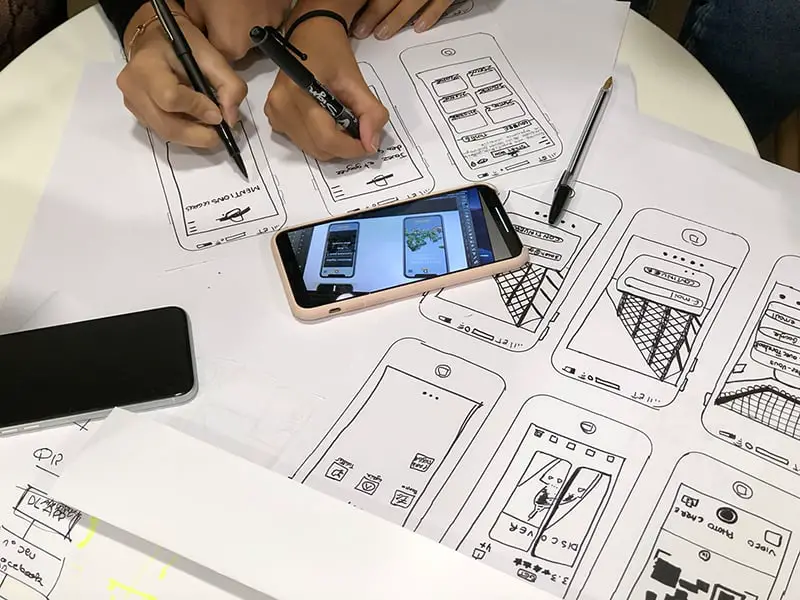Click here to get this post in PDF

We all have heard about design thinking, the approach that puts design in the priority for taking control of the user interactions with a digital solution or product. Yes, modern app development finds design as the most important attribute to engage users. This is simply because the design is visual, psychologically impacting, and subtle in tweaking user impressions.
Regarding using psychological principles for user experience design, two sides correspond to the approach, respectively giving user interactions a priority and human-centric design a priority. Largely these two aspects are represented by the principle of human-centred design and user experience design. Human-centred design is the gross and larger principle ruling the design decisions for any interface to make it more accessible and useful for humans. In contrast, user experience design is all about utilizing key psychological principles to improve an app’s specific user experience. The former has a larger scope, while the latter has a very limited scope.
For the app developers India, both of these design principles play crucial roles. Most of the leading development companies in India and elsewhere invariably focus on utilizing these design principles in their digital products and applications. In this blog, we are going to define and explain the key characteristics of these two design principles.
What is a Human-Centred Design?
Human-centred design (HCD) is a design principle that delivers design-oriented solutions to problems that are associated with the human perspective or human state of mind. Human-centred design is the larger and basic principle that is utilized across other design principles and approaches, including UX design, industrial design, architectural design, and other design niches.
In human-centred design, solving a problem from the human perspective by applying human logic is more important.
What is User Experience Design?
User experience design is a small subset or area of human-centred design that focuses particularly on improving user satisfaction with a digital product. UX design companies try to improve user satisfaction principally by making the digital solution more accessible, easier to use, and pleasurable. The UX design firm San Francisco, for example, considers every design element from the perspective of ease of use and user satisfaction.
Now that the basic definition of both design principles is clear, let us admit that both design principles are focused on solving problems for people. While the first, in trying to solve problems, focus on the larger attributes of human interactions, the second mainly focuses on the ease of use and user satisfaction in the context of a digital app. Now let us explain the key characteristics of both design principles in detail.
Key Characteristics of Human-Centered Design
For several years, we have been accustomed to the grounding principles and rules of how human-centred design works and benefits people. The human-centred design comes with an organizing strategy to solve problems corresponding to either usability or business conversion or fulfilling context-based needs. Several leading companies all over the world, including Facebook, Apple, Google, Lego, and IKEA, used this principle for their product design.
By applying human principles in the design process, the human-centred design focuses on establishing a sustainable relationship between consumers and products.
Some of the key questions that make the very basis of the human-centered design include the following.
- Who are the users or consumers of your product? Does the product design address the characteristic attributes of these consumers?
- Why would consumers like to use the product? What purpose does the product serve for them, or how do the consumers benefit from it?
- How do consumers expect to experience the product in different contexts?
- When and how do the consumers interact with the design attributes of the product?
- What is the impression that the product created on the minds of the consumers after first or initial use?
Key Characteristics of UX design
UX design is more concentrated on improving the ease of use and interactions for the consumers and users. It basically insists on making the lives of the users easier and boosting the app output in terms of business conversion and user engagement parameters. Today’s software applications, mobile apps, and other digital solutions utilize UX design principles to boost user engagement and business conversion.
Key characteristics of UX design include the following.
- User experience takes in its purview of the whole process of product design.
- The design process considers the psychological principles regarding the specific user contexts for the app.
- A UX designer focuses on UI design, along with shaping many elements crucial for the user experience.
- Smooth usability and ease of use are two crucial focus areas for any UX designer.
- Assessing usability, ease of use, and natural interactions are key user experience (UX) design attributes.
Conclusion
Almost every modern product today invariably follows the human-centred design principle, while most digital solutions and applications targeted at a specific audience focus on the user experience design to boost usability and user engagement. So, these design principles will continue to play a decisive role in the years to come in shaping the digital interactions and usability of the products and solutions.
You may also like: 5 Ways Mobile Application Is A Must For Export Business
Image source: Unsplash.com
